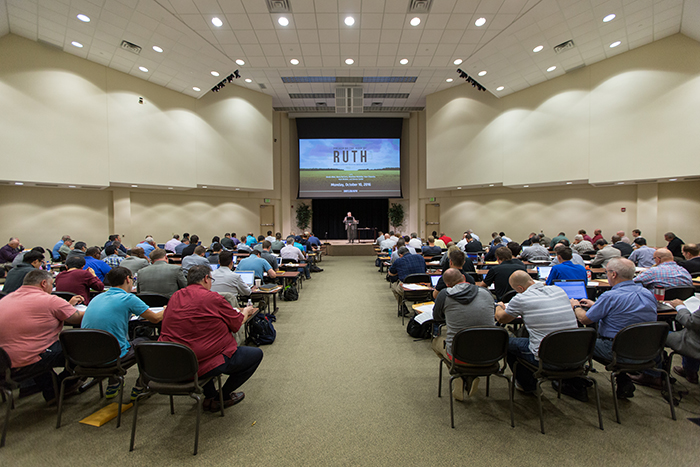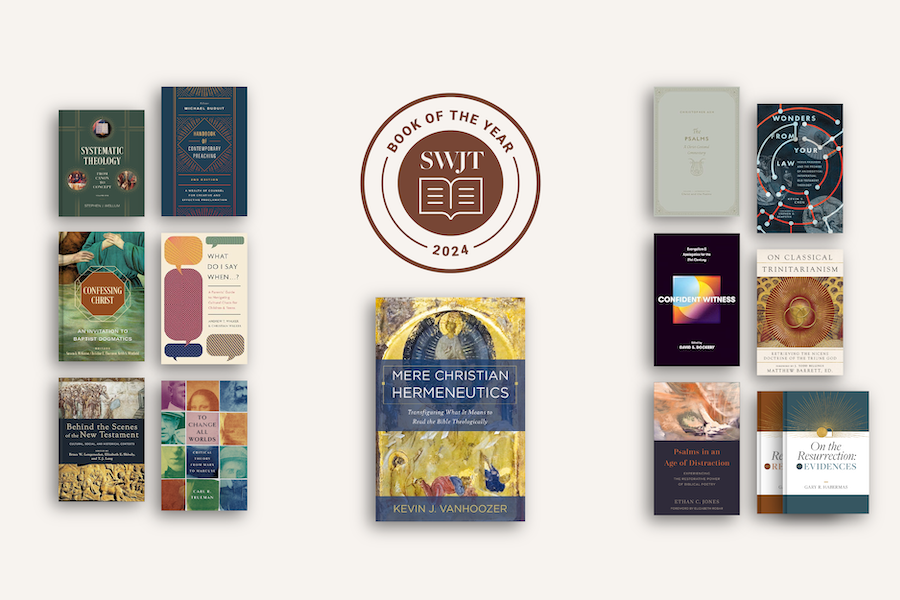Study of Ruth highlights grace, sovereignty of God

This year’s Advanced Expository Preaching Workshop, the first such workshop under Southwestern Seminary’s new School of Preaching, explored how to preach the Old Testament book of Ruth. Though this text tells the story of Naomi, Ruth and Boaz—ancestors of King David—Dean of the School of Preaching David Allen clarified that the book is not actually about any of these characters; rather, the book is about God.
“I think the book of Ruth is about God and His grace and His sovereignty,” Allen said. “It’s [about] God and how He brings His grace through His sovereignty to preserve His people and to prepare for the coming of the Messiah.”
Allen led the opening session of the daylong workshop, Oct. 10, providing an overview of the book. Other School of Preaching faculty led the remaining sessions, covering each of the four chapters as well as the topic of how to preach Christ from the book.
Steven Smith, vice president for student services and professor of communication, devoted his session to this lattermost topic. He explained that such a task is about more than just preaching Christ, however; it is about making people fall in love with the Word of God.
“So what ways help us accomplish that?” he asked. “Well, since the Word itself has this rich composition, it would seem that we only help people when we show them this. So first we teach them the text, and then we show them how this exact text or the ideas in the text weave themselves into the tapestry.”
Smith explained that, after beginning with the text at hand—that is, any passage in Ruth—the preacher should proceed to tie that passage into the overall book, then the Old Testament, then the entire canon of Scripture in order to contextualize its place in God’s overarching story. “So I wouldn’t go necessarily from Ruth to Jesus,” Smith said. “I think a more helpful thing to teach people the storyline of the Bible and how it’s composed is to take them from Ruth to David to Jesus. Why not do that so they get the whole story?”
Barry McCarty, professor of preaching and rhetoric, fleshed out this principle as he spoke on Ruth 1. Alluding to his recent chapel sermon on this passage (see here), McCarty noted that while the chapter ends with Naomi bereft of her family and bitter against God, there is good news nevertheless: the barley harvest is just beginning.
“Don’t lose hope in the good that God will do for you in the future,” McCarty said. “In this darkest moment, when they are at rock bottom, when the story is at its darkest, there is a barley harvest just on the other side of it.
“They’re going to be fed, and not only are they going to be fed in that barley harvest, but it’s going to be the scene in which Ruth meets Boaz, and he’s going to arise as a kinsman-redeemer, and not just a kinsman-redeemer for them, but a kinsman-redeemer for you. Because at the end of this story, Ruth and Boaz are going to lay a child on Naomi’s breast, and that child is going to be Obed, the grandfather of King David, the greatest and mightiest of all the kings of Israel. They are going to lay on her breast an ancestor of Jesus Christ, your Savior. All of that came because of a barley harvest.”
Matthew McKellar, associate professor of preaching, covered Chapter 2, inviting the assembled pastors and students to ponder the providence of God. Citing how Ruth “happened to come” to Boaz’s field to glean (verse 3), McKellar said the writer of the book urges upon his readers “a delight in the security of the providence of God.”
“When you take refuge in the Lord, you can expect His providential care,” McKellar explained. “When you abandon yourself entirely to Him, when you devote yourself to His faithfulness, He will not forsake you.”
Assistant Professor of Preaching Vern Charette addressed Chapter 3, in which Ruth follows Naomi’s suggestion to seek redemption in Boaz. Charette provided conference attendees a sample sermon outline for the chapter, which he titled “The Cooperative Program—Effort Meets Grace.”
“Naomi prayed for this,” Charette explained regarding Ruth and Boaz’s pairing. “This isn’t her setting forth some plan in the flesh, to try to make the will of God happen; she’s being led by the Spirit. She’s praying, and the plan unfolds perfectly.”
Charette explained that the question raised by the text is, “How does God work through the efforts of His creatures?” The text then provides the answer: “God providentially works through our efforts for ultimate good.” Charette concluded, “Since God is at work in our lives, we should act in faith, leaving the results to Him.”
Assistant Professor of Homiletics Kyle Walker concluded the study by examining Ruth 4, noting that the book, as it concludes in this final chapter, presents God as a trustworthy King, a kind Provider, and a merciful Lord. “God brings His people from death to life, from curse to blessing, from bitterness to happiness, from emptiness to fullness, and from despair to hope,” Walker said.
Connecting the genealogy at the end of the book to the one found in Matthew 1, which places Ruth and Boaz in the family line of Jesus, Walker concluded, “God is weaving your story into His story; find your purpose and identity in Him. The same God at work in the lives of Ruth and Boaz and Naomi is at work in your life. God is using ordinary people to accomplish His extraordinary purposes.”



